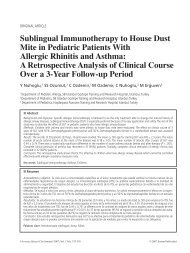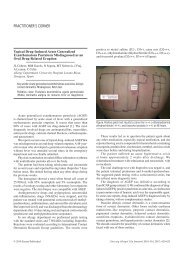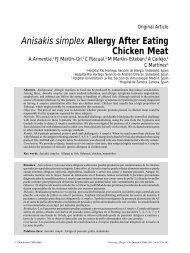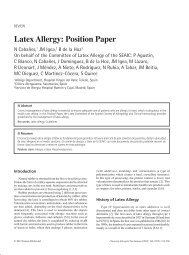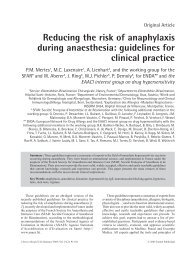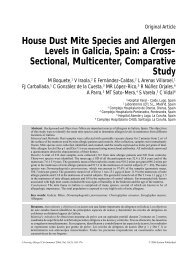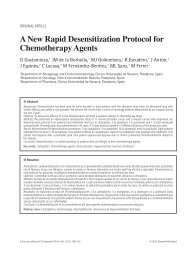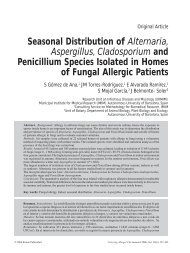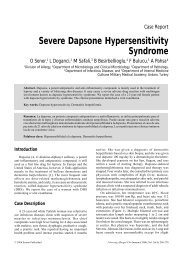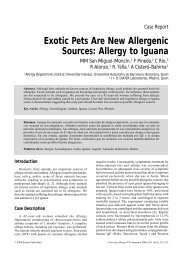Effect of H1 antihistamines upon the cardiovascular system
Effect of H1 antihistamines upon the cardiovascular system
Effect of H1 antihistamines upon the cardiovascular system
You also want an ePaper? Increase the reach of your titles
YUMPU automatically turns print PDFs into web optimized ePapers that Google loves.
<strong>Effect</strong> <strong>of</strong> H 1<br />
<strong>antihistamines</strong> <strong>upon</strong> <strong>the</strong> <strong>cardiovascular</strong> <strong>system</strong><br />
<strong>Effect</strong> <strong>of</strong> H 1<br />
<strong>antihistamines</strong> <strong>upon</strong> <strong>the</strong><br />
<strong>cardiovascular</strong> <strong>system</strong><br />
I Dávila 1 , J Sastre 2 , J Bartra 3 , A del Cuvillo 4 , I Jáuregui 5 , J Montoro 6 ,<br />
J Mullol 7 , AL Valero 3<br />
1<br />
Servicio de Alergia. Hospital Clínico. Salamanca, Spain; 2 Servicio de Alergia. Fundación Jiménez Díaz. Madrid,<br />
Spain; 3 Unitat d’Al·lèrgia. Servei de Pneumologia i Al·lèrgia Respiratòria. Hospital Clínic (ICT). Barcelona,<br />
Spain; 4 Clínica Dr. Lobatón. Cádiz, Spain; 5 Unidad de Alergología. Hospital de Basurto. Bilbao, Spain; 6 Unidad<br />
de Alergia. Hospital La Plana. Villarreal (Castellón), Spain; 7 Unitat de Rinologia, Servei d’Otorinolaringologia<br />
(ICEMEQ). Hospital Clínic. Barcelona, Spain<br />
The <strong>antihistamines</strong> are among <strong>the</strong> most widely<br />
prescribed drugs in <strong>the</strong> world. For <strong>the</strong> treatment <strong>of</strong> allergic<br />
diseases. The first generation <strong>antihistamines</strong>, such as<br />
hydroxyzine, dexchlorpheniramine or diphenhydramine,<br />
among o<strong>the</strong>rs, pose <strong>the</strong> inconvenience <strong>of</strong> inducing<br />
sedative effects and – depending on <strong>the</strong> molecule involved<br />
– anticholinergic, alpha-adrenergic or o<strong>the</strong>r actions that<br />
limit <strong>the</strong>ir usefulness. The introduction <strong>of</strong> <strong>the</strong> new second<br />
generation, non-sedating <strong>antihistamines</strong> represented an<br />
important advance in <strong>the</strong> treatment <strong>of</strong> different allergic<br />
disorders, and particularly rhinoconjunctivitis.<br />
These new drugs, which are ever increasing in<br />
number (astemizole, terfenadine and fex<strong>of</strong>enadine,<br />
cetirizine and levocetirizine, loratadine and desloratadine,<br />
ebastine, mizolastine and rupatadine, as <strong>the</strong> most salient<br />
examples), are relatively free <strong>of</strong> side effects and <strong>of</strong>fer a<br />
broad <strong>the</strong>rapeutic spectrum. However, in <strong>the</strong> last decade<br />
<strong>of</strong> <strong>the</strong> twentieth century, reports began to appear <strong>of</strong><br />
torsades de pointes (TdP) type arrhythmias, arrhythmias,<br />
syncope and even sudden death, fundamentally related<br />
with astemizole [1] and terfenadine [2], which generated<br />
considerable concern and drew attention to <strong>the</strong> cardiac<br />
effects <strong>of</strong> <strong>the</strong> <strong>antihistamines</strong>.<br />
Histamine exerts a series <strong>of</strong> actions <strong>upon</strong> <strong>the</strong><br />
<strong>cardiovascular</strong> <strong>system</strong>. Thus, through mediation <strong>of</strong><br />
<strong>the</strong> H 1<br />
and H 2<br />
receptors, histamine increases vascular<br />
permeability and induces hypotension, with reflex<br />
tachycardia. In turn, at heart muscle level, histamine<br />
action <strong>upon</strong> <strong>the</strong> H 1<br />
receptors induces an increase in<br />
atrioventricular node conduction, while <strong>the</strong> H 2<br />
receptors<br />
mediate positive chronotropic and inotropic effects<br />
[3]. The H 1<br />
<strong>antihistamines</strong>, as inverse agonists, exert<br />
<strong>the</strong> opposite effect, with partial countering <strong>of</strong> <strong>the</strong><br />
aforementioned actions. However, <strong>the</strong> main concern in<br />
relation to <strong>the</strong> <strong>cardiovascular</strong> safety <strong>of</strong> <strong>the</strong> <strong>antihistamines</strong><br />
refers to <strong>the</strong>ir cardiac arrhythmogenic potential. A review<br />
is provided below <strong>of</strong> <strong>the</strong> principles and clinical particulars<br />
<strong>of</strong> <strong>the</strong>se worrisome adverse effects.<br />
© 2006 Esmon Publicidad<br />
Cardiac action potential<br />
In order to correctly understand <strong>the</strong> effect <strong>of</strong><br />
<strong>antihistamines</strong> <strong>upon</strong> <strong>the</strong> heart, a brief reminder<br />
<strong>of</strong> <strong>the</strong> cardiac action potential is indicated. The<br />
surface electrocardiogram (ECG) records <strong>the</strong><br />
electrophysiological process whereby electric<br />
impulses are generated and conducted through <strong>the</strong><br />
heart muscle tissue. Thus, <strong>the</strong> P wave represents <strong>the</strong><br />
electrophysiological action potential <strong>of</strong> <strong>the</strong> atria,<br />
while <strong>the</strong> QRS complex reflects <strong>the</strong> ventricular action<br />
potential (which masks atrial repolarization), and <strong>the</strong> T<br />
wave corresponds to ventricular repolarization. In turn,<br />
<strong>the</strong> QT interval, which extends from <strong>the</strong> Q wave to <strong>the</strong><br />
end <strong>of</strong> <strong>the</strong> T wave, reflects <strong>the</strong> duration <strong>of</strong> <strong>the</strong> action<br />
potential plus <strong>the</strong> time associated with electric impulse<br />
transmission through <strong>the</strong> ventricles. The QT interval,<br />
which usually has a duration <strong>of</strong> between 200-300 ms,<br />
must be less than 440 ms in males and 460 ms in females.<br />
Above <strong>the</strong>se limits we speak <strong>of</strong> a prolongation <strong>of</strong> <strong>the</strong><br />
QT interval (or long QT), and <strong>the</strong> risk <strong>of</strong> ventricular<br />
arrhythmias increases. Never<strong>the</strong>less, it should be stated<br />
that a correction must be applied to <strong>the</strong> QT value, to<br />
avoid alterations attributable to heart rate.<br />
The cardiac action potential is generated by <strong>the</strong><br />
combined action <strong>of</strong> different ion channels that induce<br />
different ion input and output currents (Figure 1). In <strong>the</strong><br />
same way as o<strong>the</strong>r cells, <strong>the</strong> interior <strong>of</strong> <strong>the</strong> cardiac cells<br />
is negatively charged with respect to <strong>the</strong> exterior, with<br />
a resting transmembrane potential difference <strong>of</strong> –80 to<br />
–90 mV, which is close to <strong>the</strong> electrochemical potential<br />
for potassium ions, due to <strong>the</strong> high K + conductance under<br />
resting conditions. However, cardiac cells are excitable,<br />
and an adequate stimulus serves to sequentially open<br />
and close a series <strong>of</strong> membrane ion channels, giving rise<br />
to changes in <strong>the</strong> transmembrane potential difference<br />
that in turn produce <strong>the</strong> cardiac action potential (Figure<br />
1). Basically, and starting from <strong>the</strong> negative baseline<br />
J Investig Allergol Clin Immunol 2006; Vol. 16, Supplement 1: 13-23
14<br />
I Dávila et al<br />
CURRENTS<br />
Na + current<br />
Type L Ca 2+ current<br />
Type T Ca 2+ current<br />
Na + - Ca 2+ exchange<br />
I TO 1<br />
(4-AP sensitive)<br />
I TO 2<br />
(Ca 2+ activated)<br />
I KS<br />
I KR<br />
I KI<br />
I CI or I KP<br />
I KUR<br />
I K ATP/ACh<br />
IONIC TRANSPORTERS<br />
Na v<br />
1.5 and beta subunits<br />
Ca v<br />
1.2 and auxiliary subunits<br />
Ca v<br />
3.2 and auxiliary subunits<br />
Na + - Ca 2+ exchanger<br />
K v<br />
4.3<br />
–<br />
K v<br />
7.1 (KCNQ1) + MinK (KCNE1)<br />
K v<br />
11.1 (hERG) and Mir P1 (KCNE2)<br />
K ir<br />
2.1<br />
CFTR (CI-), K2P family<br />
K v<br />
1.5<br />
GIRK 1+4 (I K-ACh<br />
), Kir 6.2 + SUR1 (I KATP<br />
)<br />
Figure 1. Cardiac action potential and ionic currents. Reproduced with permission from [9]. See text for explanation.<br />
resting value (due to <strong>the</strong> high potassium conductance),<br />
a fast depolarizing Na 2+ influx current (referred to as<br />
I Na<br />
) is produced, giving rise to phase 0 <strong>of</strong> <strong>the</strong> cardiac<br />
action potential; <strong>the</strong> action <strong>of</strong> this current modifies <strong>the</strong><br />
potential difference from –90 mV to +30 mV [4,5]. This<br />
in turn is followed by a transient potassium efflux current<br />
(I to<br />
), responsible for a small repolarization taking place<br />
immediately afterwards, and which represents phase<br />
1 <strong>of</strong> <strong>the</strong> cardiac action potential. This current is very<br />
important in rats and mice, due to <strong>the</strong>ir high heart rates,<br />
though not so in o<strong>the</strong>r species such as <strong>the</strong> dog, guinea<br />
pig, weasel or humans. During <strong>the</strong> plateau phase (phase<br />
2), <strong>the</strong> action potential is maintained by <strong>the</strong> effect <strong>of</strong> a<br />
Ca 2+ ion influx current (ICa). The repolarization phase<br />
(phase 3) is due to <strong>the</strong> efflux <strong>of</strong> K + ions, fundamentally<br />
as a consequence <strong>of</strong> <strong>the</strong> effect <strong>of</strong> <strong>the</strong> so-called fast<br />
(I Kr<br />
) and slow components (I Ks<br />
), <strong>the</strong> late rectifying<br />
potassium current, which induce repolarization and<br />
gradually return <strong>the</strong> action potential to its resting state.<br />
The last phase (phase 4), referred to as <strong>the</strong> diastolic<br />
depolarization phase, is due to <strong>the</strong> decrease in activity<br />
<strong>of</strong> <strong>the</strong> two late rectifying current components, and to <strong>the</strong><br />
effect <strong>of</strong> <strong>the</strong> input pacemaker current (I f<br />
), and <strong>the</strong> weak<br />
background sodium influx current (I Na-B<br />
). There are also<br />
o<strong>the</strong>r, different potassium channels in <strong>the</strong> heart [6],<br />
which when blocked can give rise to different effects<br />
<strong>upon</strong> <strong>the</strong> cardiac action potential.<br />
The no less than 8 potassium currents described<br />
for <strong>the</strong> heart [7] show different opening and closing<br />
characteristics, as well as differences in time<br />
dependence, frequency and voltage, and in terms<br />
<strong>of</strong> <strong>the</strong>ir regulation and <strong>the</strong> effects <strong>of</strong> drugs. Each <strong>of</strong><br />
<strong>the</strong>se currents exerts a different effect <strong>upon</strong> <strong>the</strong> action<br />
potential, though under normal conditions <strong>the</strong> main<br />
currents that participate in repolarization <strong>of</strong> <strong>the</strong> action<br />
potential are <strong>the</strong> late rectifying potassium current (I Kr<br />
and I Ks<br />
), <strong>the</strong> influx rectifying current (I Ki<br />
), and <strong>the</strong><br />
transient efflux current (I to<br />
). Drug-induced arrhythmias<br />
are fundamentally mediated by drugs that suppress <strong>the</strong><br />
I Ki<br />
and I kr<br />
channels, which control <strong>the</strong> fast repolarization<br />
phase. Although it was initially speculated that <strong>the</strong> first<br />
<strong>of</strong> <strong>the</strong>se two channels was responsible for TdP induced<br />
by <strong>antihistamines</strong> [8], it was subsequently shown that<br />
<strong>the</strong> main cardiac adverse effects <strong>of</strong> <strong>the</strong> <strong>antihistamines</strong><br />
are attributable to IKr current block.<br />
Determination <strong>of</strong> <strong>the</strong> QT interval [9]<br />
For determination <strong>of</strong> <strong>the</strong> QT interval it is preferable<br />
J Investig Allergol Clin Immunol 2006; Vol. 16, Supplement 1: 13-23<br />
© 2006 Esmon Publicidad
<strong>Effect</strong> <strong>of</strong> H 1<br />
<strong>antihistamines</strong> <strong>upon</strong> <strong>the</strong> <strong>cardiovascular</strong> <strong>system</strong><br />
15<br />
Table 1. Normal values <strong>of</strong> <strong>the</strong> QT interval, corrected<br />
according to <strong>the</strong> Bazett formula (modified from Yap and<br />
Camm) [84]. The values are expressed in milliseconds.<br />
© 2006 Esmon Publicidad<br />
Normal Limiting Prolonged<br />
Adult males 450<br />
Adult females 470<br />
Children 460<br />
to record <strong>the</strong> surface ECG at a speed <strong>of</strong> 50 mm/s and<br />
with an amplitude <strong>of</strong> 0.5 mV/s, using a multichannel<br />
<strong>system</strong> capable <strong>of</strong> simultaneously recording all 12 leads.<br />
To measure <strong>the</strong> QT interval, we trace a line tangential to<br />
<strong>the</strong> zone <strong>of</strong> greatest slope <strong>of</strong> <strong>the</strong> descending portion <strong>of</strong><br />
<strong>the</strong> T wave. The intersection point between this tangent<br />
and <strong>the</strong> isoelectric line defines <strong>the</strong> end <strong>of</strong> <strong>the</strong> T wave. The<br />
interval between <strong>the</strong> start <strong>of</strong> <strong>the</strong> QRS complex and <strong>the</strong> end<br />
<strong>of</strong> <strong>the</strong> T line in turn defines <strong>the</strong> length <strong>of</strong> <strong>the</strong> QT interval.<br />
The small physiological U waves should not be included<br />
in measurement <strong>of</strong> <strong>the</strong> QT interval. It is preferable to<br />
determine <strong>the</strong> interval from <strong>the</strong> second axial lead (DII),<br />
because on this lead <strong>the</strong> repolarization vectors tend to<br />
give rise to a single wave instead <strong>of</strong> a T wave and a U<br />
wave. Never<strong>the</strong>less, <strong>the</strong> U waves that are not separated<br />
from <strong>the</strong> T wave are considered to be pathological, and<br />
can be included in <strong>the</strong> QT interval.<br />
The QT interval is influenced by heart rate. Therefore,<br />
3-4 RR intervals before <strong>the</strong> QT interval are to be measured<br />
to correct for frequency. Posteriorly, we apply one <strong>of</strong><br />
several possible correction formulas. The most widely<br />
used formulas are those <strong>of</strong> Bazett (QTc = QT/RR 1/2 ) and<br />
Fridericia (QTc = QT/RR 1/3 ). The former is more popular,<br />
though <strong>the</strong> latter is more exact for extreme heart rate<br />
values. RR is expressed in seconds, as a result <strong>of</strong> which<br />
in both cases, when RR = 1, i.e., <strong>the</strong> heart rate is 60 beats<br />
per minute (bpm), <strong>the</strong> QTc = QT. The normal values are<br />
reported in Table 1.<br />
At present, new repolarization parameters are being<br />
considered, such as QT dispersion (maximum – minimum<br />
QT interval), for assessing <strong>the</strong> efficacy and safety <strong>of</strong><br />
drugs [10]. An update <strong>of</strong> <strong>the</strong> methods used to evaluate<br />
drug-induced TdP has been published by H<strong>of</strong>fman and<br />
Warner [11].<br />
On <strong>the</strong> o<strong>the</strong>r hand, <strong>the</strong> QT interval also varies<br />
according to patient gender, being longer in women<br />
– probably because <strong>the</strong>ir cardiac cells generate lesser<br />
repolarization currents [12]. Recently, <strong>the</strong> concept <strong>of</strong><br />
cardiac repolarization reserve has been introduced,<br />
defined as a physiological reserve found in each individual<br />
to counter exogenous or endogenous factors capable <strong>of</strong><br />
affecting cardiac repolarization. This reserve is extremely<br />
variable and may be reduced in some individuals. In <strong>the</strong><br />
case <strong>of</strong> women, <strong>the</strong> concept could explain <strong>the</strong>ir tendency<br />
to develop TdP when taking medicines that control <strong>the</strong><br />
QT interval [13]. In some cases a genetic basis may<br />
exist, such as in <strong>the</strong> frustrated form <strong>of</strong> long QT syndrome<br />
[14].<br />
Long QT syndrome<br />
The long QT syndrome (LQTS) is one <strong>of</strong> <strong>the</strong> best<br />
known heart diseases. Since its first description, important<br />
advances have been made in our knowledge <strong>of</strong> its<br />
electrophysiological and genetic bases. In 1957, Jerwell<br />
and Lange-Nielsen described <strong>the</strong> electrocardiographical<br />
principles <strong>of</strong> <strong>the</strong> disorder, in a description <strong>of</strong> four deaf<br />
children – three <strong>of</strong> which died prematurely – and who<br />
presented a prolongation <strong>of</strong> <strong>the</strong> QT interval [15]. From<br />
<strong>the</strong> historical perspective, as early as 1856 Meissner [16]<br />
described <strong>the</strong> case <strong>of</strong> a deaf girl who suffered a collapse<br />
and died after being punished in school. The girl had two<br />
siblings that also died after an episode <strong>of</strong> fright and anger,<br />
respectively. Following <strong>the</strong> description by Jervell and<br />
Lange-Nielsen, o<strong>the</strong>r congenital cases without deafness<br />
began to be reported [17,18], yielding a total <strong>of</strong> ten<br />
familial long QT syndromes (see Table 2). Developments<br />
in genetics have made a fundamental contribution to<br />
<strong>the</strong> subject, by allowing linking analyses, which have<br />
shown that <strong>of</strong> <strong>the</strong> genes associated with familial long QT<br />
syndrome, <strong>the</strong> majority encode for subunits <strong>of</strong> <strong>the</strong> ion<br />
channels found in <strong>the</strong> heart (Table 2).<br />
The first such gene to be linked to familial long<br />
QT syndrome was <strong>the</strong> HERG gene (human e<strong>the</strong>r-agogo<br />
related gene), thus named after being cloned by<br />
homology with ano<strong>the</strong>r potassium channel called e<strong>the</strong>ra-go-go<br />
[19], responsible for LQT2 (one <strong>of</strong> <strong>the</strong> types<br />
<strong>of</strong> familial long QT syndrome, <strong>of</strong> recessive autosomal<br />
inheritance). This gene encodes for <strong>the</strong> alpha subunit <strong>of</strong><br />
<strong>the</strong> voltage-dependent potassium channel that mediates<br />
<strong>the</strong> fast component <strong>of</strong> <strong>the</strong> late rectifying potassium<br />
current, I KR<br />
. It has been suggested that HERG1 mutations<br />
alter this current and induce a delay in repolarization –<br />
Table 2. Congenital and acquired forms <strong>of</strong> long QT<br />
syndrome. Reproduced from Abriel et al [9].<br />
Long QT syndrome: congenital forms<br />
Romano-Ward syndrome: LQT1-LQT6<br />
Jerwell and Lange-Nielsen syndrome: J-LN1 and J-<br />
LN2<br />
Associated to Andersen syndrome: AND1 or LQT-7<br />
Associated to syndactyly<br />
Long QT syndrome: acquired forms<br />
Antiarrhythmic drugs (class IA, IC and III)<br />
O<strong>the</strong>r drugs (antibiotics, antifungals, psychotropic<br />
agents, etc.)<br />
Heart disease (heart failure, myocardiopathy, etc.)<br />
Electrolytic disorders: hypopotassemia, hypocalcemia,<br />
hypomagnesemia<br />
Nutritional disorders (alcoholism, anorexia, etc.)<br />
O<strong>the</strong>rs<br />
LQT: long QT syndrome; J-LN: Jerwell and Lange-Nielsen syndrome; AND:<br />
Andersen syndrome<br />
J Investig Allergol Clin Immunol 2006; Vol. 16, Supplement 1: 13-23
16<br />
I Dávila et al<br />
which in turn represents a mechanism for triggering TdP<br />
[20]. Never<strong>the</strong>less, <strong>the</strong>re are different types <strong>of</strong> familial<br />
long QT syndrome that affect different ion channels,<br />
with diverse hereditary patterns, and some are more<br />
over associated with o<strong>the</strong>r anomalies.<br />
In addition to <strong>the</strong> congenital etiology <strong>of</strong> long<br />
QT syndrome, <strong>the</strong>re are a series <strong>of</strong> acquired causes<br />
[21]. Among <strong>the</strong>m, mention may be made <strong>of</strong> certain<br />
cardiac diseases such as congestive heart failure or<br />
myocardiopathies; hydroelectrolytic disturbances such as<br />
hypocalcemia, hypopotassemia or hypomagnesemia; <strong>the</strong><br />
use <strong>of</strong> antiarrhythmic drugs such as those corresponding<br />
to classes IA, IC and III; <strong>the</strong> use <strong>of</strong> o<strong>the</strong>r drugs such as<br />
antibiotics, antifungals or psychotropic agents; or certain<br />
nutritional disorders (Table 2).<br />
From <strong>the</strong> above it can be inferred that <strong>the</strong>re are a<br />
series <strong>of</strong> risk factors implicated in <strong>the</strong> possibility <strong>of</strong><br />
developing long QT syndrome and TdP, including <strong>the</strong><br />
following [21]: Female gender (71% <strong>of</strong> all patients),<br />
heart disease (41%), <strong>the</strong> administration <strong>of</strong> two or more<br />
QT-prolonging drugs (39%), or hypopotassemia (28%).<br />
In only 18% <strong>of</strong> cases is <strong>the</strong>re a family history <strong>of</strong> long QT<br />
syndrome (LQTS), a previous TdP episode, or a clearly<br />
prolonged QT interval before drug ingestion. O<strong>the</strong>r<br />
potential risk factors are liver failure or <strong>the</strong> consumption<br />
<strong>of</strong> certain foods – fundamentally grapefruit juice, which<br />
contains furanocoumarins, which in turn are potent<br />
inhibitors <strong>of</strong> <strong>the</strong> CYP3A4 isoenzyme and induce rapid<br />
loss <strong>of</strong> intestinal enzyme activity – though <strong>the</strong>y do not<br />
inhibit liver CYP3A4 [22].<br />
The HERG gene<br />
Molecular biological studies have shown I KR<br />
to be<br />
<strong>the</strong> result <strong>of</strong> <strong>the</strong> heteromeric binding <strong>of</strong> subunits encoded<br />
for by <strong>the</strong> HERG and MiRP genes(KCNE2)[23]. The<br />
HERG (human e<strong>the</strong>r-a-gogo related gene) encodes for<br />
<strong>the</strong> alpha subunit <strong>of</strong> <strong>the</strong> voltage-dependent potassium<br />
channel that mediates <strong>the</strong> fast component <strong>of</strong> <strong>the</strong> late<br />
rectifying potassium current, Kv11.1 (I KR<br />
). The HERG<br />
gene was originally cloned in 1994 from a <strong>system</strong>atic<br />
search <strong>of</strong> a human hippocampus gene library [24]. The<br />
purported structure <strong>of</strong> <strong>the</strong> HERG channel, comprising<br />
1159 amino acids, shows it to be similar to o<strong>the</strong>r members<br />
<strong>of</strong> <strong>the</strong> voltage-dependent potassium channel family.<br />
Basically (Figure 2), <strong>the</strong>se channels consist <strong>of</strong> four<br />
subunits, each containing 6 alpha-helix transmembrane<br />
domains and a loop conforming <strong>the</strong> “pore region” [25].<br />
The transmembrane domains (S1-S6) are functionally<br />
organized so that domains S5 and S6, and <strong>the</strong> loop <strong>of</strong> <strong>the</strong><br />
pore region, constitute <strong>the</strong> channel pore, while domain<br />
S4 includes a series <strong>of</strong> charged and regularly spaced<br />
amino acids that function as a voltage sensor [26]. Both<br />
<strong>the</strong> carboxyterminal and <strong>the</strong> aminoterminal extreme are<br />
located within <strong>the</strong> cells. The I KR<br />
channel encoded for by<br />
<strong>the</strong> HERG gene is one <strong>of</strong> <strong>the</strong> main channels implicated<br />
in human ventricular repolarization.<br />
A<br />
B<br />
Outside<br />
4 <br />
Plasma<br />
membrane<br />
Within<br />
Cytoplasm<br />
NH 2<br />
Extracellular<br />
space<br />
Alpha hERG subunit<br />
NH<br />
-COOH<br />
-COOH<br />
Figure 2. Structure <strong>of</strong> <strong>the</strong> HERG potassium channel.<br />
Reproduced with permission from [9]. See text for<br />
explanation.<br />
Most drugs capable <strong>of</strong> prolonging <strong>the</strong> QT interval do<br />
so by blocking <strong>the</strong> HERG channel (Kv11.1). However,<br />
<strong>the</strong> opposite does not always apply. In effect, in <strong>the</strong><br />
clinical setting, <strong>the</strong> hypothyroidism, <strong>the</strong> administration<br />
<strong>of</strong> amiodarone and <strong>the</strong> presence <strong>of</strong> severe hypocalcemia<br />
induce a marked prolongation <strong>of</strong> <strong>the</strong> QT interval,<br />
though this is only rarely associated with TdP – unless<br />
concomitant water-electrolyte alterations are present<br />
[27]. A characteristic common to <strong>the</strong> three processes<br />
is <strong>the</strong> fact that <strong>the</strong>y induce marked inhibition <strong>of</strong> <strong>the</strong><br />
type L Ca 2+ currents (I CaL<br />
). Moreover, treatment with<br />
magnesium also attenuates <strong>the</strong> flow <strong>of</strong> Ca 2+ towards<br />
<strong>the</strong> interior <strong>of</strong> <strong>the</strong> cell, and is effective in abolishing<br />
<strong>the</strong> arrhythmia in TdP – though it fails to completely<br />
normalize <strong>the</strong> QT interval [28].<br />
Citalopram, a specific serotonin reuptake inhibitor<br />
(SSRI), blocks <strong>the</strong> HERG channel at concentrations<br />
similar to those <strong>of</strong> o<strong>the</strong>r tricyclic antidepressants,<br />
though it also blocks I CaL<br />
[29]; this protective effect <strong>of</strong><br />
I CaL<br />
block may explain <strong>the</strong> low fatal toxicity associated<br />
with <strong>the</strong> SSRIs [30]. As regards <strong>the</strong> reason why <strong>the</strong> drugs<br />
specifically block this channel, mention should be made<br />
<strong>of</strong> two recently described principal characteristics <strong>of</strong> <strong>the</strong><br />
channel. On one hand, and unlike <strong>the</strong> o<strong>the</strong>r channels,<br />
it lacks two proline groups in segment S6; in o<strong>the</strong>r<br />
J Investig Allergol Clin Immunol 2006; Vol. 16, Supplement 1: 13-23<br />
© 2006 Esmon Publicidad
<strong>Effect</strong> <strong>of</strong> H 1<br />
<strong>antihistamines</strong> <strong>upon</strong> <strong>the</strong> <strong>cardiovascular</strong> <strong>system</strong><br />
17<br />
channels, <strong>the</strong>se amino acids induce an acute angle – thus<br />
markedly reducing <strong>the</strong> pore volume. However, Kv11.1<br />
lacks this angle, and consequently its pore volume is<br />
much greater – thus making it possible to accommodate<br />
chemical structures much larger than in <strong>the</strong> case <strong>of</strong> <strong>the</strong><br />
o<strong>the</strong>r potassium channels [31]. On <strong>the</strong> o<strong>the</strong>r hand, <strong>the</strong><br />
channel possesses two aromatic amino acids (tyrosine<br />
and phenylalanine) that allow interaction with aromatic<br />
rings present in drugs that are able to block receptors<br />
<strong>of</strong> this kind [9]. There have even been descriptions <strong>of</strong><br />
polymorphisms in <strong>the</strong> encoding gene that may condition<br />
increased susceptibility to this effect.<br />
Methods for studying <strong>the</strong> effects <strong>of</strong><br />
drugs <strong>upon</strong> <strong>the</strong> Kv11.1 channel<br />
A number <strong>of</strong> methods have been developed for<br />
evaluating <strong>the</strong> effects <strong>of</strong> drugs <strong>upon</strong> <strong>the</strong> Kv11.1<br />
potassium channel. On one hand, evaluations can be<br />
made in mammalian cell lines or in oocytes <strong>of</strong> Xenopus<br />
laevis genetically manipulated to specifically express<br />
this channel [32]. On <strong>the</strong> o<strong>the</strong>r hand, <strong>the</strong>re are also<br />
experimental electrophysiological models, including<br />
human myocytes, though full-heart <strong>system</strong>s have also been<br />
developed, as well as Purkinje fiber models, or papillary<br />
muscle and ventricular muscle preparations <strong>of</strong> different<br />
species (e.g., dogs, rabbits or guinea pigs). These models<br />
<strong>of</strong>fer <strong>the</strong> advantage <strong>of</strong> being able to detect QT interval<br />
prolongation regardless <strong>of</strong> <strong>the</strong> ion current affected [33].<br />
Among <strong>the</strong> non-electrophysiological techniques, mention<br />
may be made <strong>of</strong> fluorescence <strong>system</strong>s that use voltagesensitive<br />
dyes, and radioactively-labeled d<strong>of</strong>etilide (a<br />
known I Kr<br />
channel blocker) competitive inhibition tests.<br />
Evaluations also may be made in vivo by evaluating<br />
<strong>the</strong> electrocardiographic changes induced by drugs in<br />
anes<strong>the</strong>tized or conscious animals. To this effect dogs<br />
are used, as well as monkeys, rabbits, pigs and guinea<br />
pigs. Studies in conscious animals without movement<br />
limitations are preferred. Although such studies are not<br />
very predictive as refers to <strong>the</strong> arrhythmogenic potential<br />
<strong>of</strong> a drug, in view <strong>of</strong> <strong>the</strong> differences between <strong>the</strong> different<br />
species and humans in terms <strong>of</strong> cardiac electrophysiology,<br />
<strong>the</strong>y do <strong>of</strong>fer <strong>the</strong> advantage <strong>of</strong> simulating pathological<br />
conditions such as hypopotassemia, bradycardia, etc.,<br />
more closely similar to <strong>the</strong> clinical setting, and allow <strong>the</strong><br />
use <strong>of</strong> pharmacological models <strong>of</strong> arrhythmia.<br />
A detailed analysis <strong>of</strong> <strong>the</strong> evaluation methods is<br />
beyond <strong>the</strong> scope <strong>of</strong> <strong>the</strong> present review, however. Updated<br />
recommendations on <strong>the</strong> procedures for evaluating <strong>the</strong><br />
arrhythmogenic potential <strong>of</strong> non-antiarrhythmic drugs are<br />
available (www.ich.org/LOB/media/MEDIA 2192.pdf).<br />
The new <strong>antihistamines</strong> and <strong>the</strong><br />
induction <strong>of</strong> arrhythmias<br />
During <strong>the</strong> nineties, some drugs without effects <strong>upon</strong><br />
<strong>the</strong> <strong>cardiovascular</strong> <strong>system</strong>, including <strong>the</strong> <strong>antihistamines</strong><br />
terfenadine and astemizole, were seen to be able to<br />
trigger torsades de pointes-type arrhythmias, susceptible<br />
to inducing tachycardia or ventricular fibrillation, or<br />
even death [34]. In most cases <strong>the</strong>se phenomena were<br />
associated to absolute [35-38] or relative overdose, due<br />
to pharmacological interactions with compounds that<br />
inhibit <strong>the</strong> P450 cytochrome <strong>system</strong> [39-44], <strong>the</strong>reby<br />
increasing <strong>the</strong> concentration <strong>of</strong> <strong>the</strong> drug. Interactions<br />
with antiarrhythmic drugs were rarely responsible [45].<br />
In o<strong>the</strong>r instances <strong>the</strong> disorders occurred in <strong>the</strong> context<br />
<strong>of</strong> some background heart disease or water-electrolyte<br />
disturbance [46]. O<strong>the</strong>r studies have demonstrated<br />
interactions between terfenadine and grapefruit juice,<br />
resulting in reduced metabolization <strong>of</strong> <strong>the</strong> drug and a<br />
significant prolongation <strong>of</strong> <strong>the</strong> QT interval [47-49].<br />
Although it has been estimated that <strong>the</strong> incidence<br />
<strong>of</strong> torsades de pointes (TdP) associated with <strong>the</strong> use <strong>of</strong><br />
terfenadine or astemizole is very low, since <strong>antihistamines</strong><br />
are fundamentally prescribed for <strong>the</strong> treatment <strong>of</strong><br />
disorders that pose no threat to patient life, such as<br />
rhinoconjunctivitis or urticaria, any life-threatening<br />
adverse effect requires very careful evaluation. As has been<br />
commented above, <strong>the</strong> reports <strong>of</strong> ventricular arrhythmias<br />
induced by terfenadine and astemizole led to research on<br />
<strong>the</strong> potential influence <strong>of</strong> <strong>the</strong> new <strong>antihistamines</strong> <strong>upon</strong><br />
<strong>the</strong> Kv11.1 channels. A summary is provided below <strong>of</strong><br />
<strong>the</strong> effects <strong>upon</strong> <strong>the</strong>se channels <strong>of</strong> <strong>the</strong> second generation<br />
<strong>antihistamines</strong> that are currently available on <strong>the</strong> Spanish<br />
market. In turn, Table 3 reports <strong>the</strong> recommendations in<br />
this sense, reflected in <strong>the</strong> Spanish Vademecum on <strong>the</strong><br />
internet (www.vademecum.medicom.es). Never<strong>the</strong>less,<br />
prior mention is required <strong>of</strong> <strong>the</strong> fact that <strong>the</strong> induction<br />
<strong>of</strong> arrhythmias <strong>of</strong> this kind is not an inherent and general<br />
effect <strong>of</strong> <strong>the</strong> second generation <strong>antihistamines</strong> [50-53],<br />
and is only associated with some compounds <strong>of</strong> this drug<br />
class, such as astemizole or terfenadine.<br />
1) Astemizole and its active metabolites<br />
Both astemizole and demethylastemizole block <strong>the</strong><br />
Kv11.1 channels [54-57]. It seems that norastemizole<br />
inhibits <strong>the</strong>se channels at higher doses, as a result <strong>of</strong> which<br />
it may have a better safety pr<strong>of</strong>ile from <strong>the</strong> cardiological<br />
perspective [55].<br />
2) Terfenadine and fex<strong>of</strong>enadine<br />
Terfenadine is known to be able to block <strong>the</strong> Kv11.1<br />
potassium channels [56,58-62]. As has already been<br />
commented, and in <strong>the</strong> same way as with astemizole, <strong>the</strong><br />
arrhythmogenic effects occur in <strong>the</strong> context <strong>of</strong> absolute<br />
or relative drug overdose.<br />
On <strong>the</strong> o<strong>the</strong>r hand, fex<strong>of</strong>enadine does not seem to<br />
affect <strong>the</strong> HERG potassium channel [53,63,64,]; doses <strong>of</strong><br />
up to 1400 mg during one week have been administered<br />
to healthy volunteers, without QT prolongation [65]. In<br />
this same study, no prolongation <strong>of</strong> <strong>the</strong> interval appeared<br />
to occur as a result <strong>of</strong> interaction with ketoconazole or<br />
erythromycin.<br />
© 2006 Esmon Publicidad<br />
J Investig Allergol Clin Immunol 2006; Vol. 16, Supplement 1: 13-23
18<br />
I Dávila et al<br />
Table 3. Recommendations regarding possible cardiac effects, found in <strong>the</strong> Spanish Vademecum on <strong>the</strong> internet (www.<br />
vademecum.medicom.es), in reference to <strong>the</strong> main second generation <strong>antihistamines</strong> used in Spain.<br />
Interactions with o<strong>the</strong>r<br />
Drug substance drugs and o<strong>the</strong>r forms <strong>of</strong> Contraindications<br />
interaction<br />
Special warnings and special<br />
precautions for use<br />
Rupatadine<br />
The concomitant administration<br />
<strong>of</strong> rupatadine and ketoconazole or<br />
erythromycin respectively induces a<br />
10- and 2- to 3-fold increase in <strong>system</strong>ic<br />
exposure to rupatadine. Therefore, it<br />
is not advisable to use rupatadine with<br />
<strong>the</strong>se drugs and in general with o<strong>the</strong>r<br />
CYP3A4 isoenzyme inhibitors.<br />
These modifications were not<br />
accompanied by changes in QT interval,<br />
and were not associated with an<br />
increase in adverse effects versus <strong>the</strong><br />
drugs administered separately.<br />
Hypersensitivity to rupatadine.<br />
Rupatadine 10 mg tablets<br />
should not be combined with<br />
ketoconazole, erythromycin or<br />
any o<strong>the</strong>r potential inhibitor<br />
<strong>of</strong> isoenzyme CYP3A4 <strong>of</strong> <strong>the</strong><br />
P450 cytochrome <strong>system</strong>, since<br />
<strong>the</strong>se drug substances increase<br />
<strong>the</strong> plasma concentration <strong>of</strong><br />
rupatadine.<br />
Mizolastine<br />
Although <strong>the</strong> bioavailability <strong>of</strong><br />
mizolastine is high and <strong>the</strong> drug is<br />
mainly metabolized via glucuronidation,<br />
<strong>the</strong> <strong>system</strong>ic dosing <strong>of</strong> ketoconazole and<br />
erythromycin moderately increases <strong>the</strong><br />
plasma concentration <strong>of</strong> mizolastine,<br />
and concomitant use is <strong>the</strong>refore<br />
contraindicated. The concomitant use<br />
<strong>of</strong> o<strong>the</strong>r potent inhibitors or substrates<br />
<strong>of</strong> liver oxidation (cytochrome P450<br />
3A4) with mizolastine must be carried<br />
out with caution. Such drugs include<br />
cimetidine, cyclosporine and nifedipine.<br />
Hypersensitivity to mizolastine.<br />
Concomitant dosing with<br />
<strong>system</strong>ic imidazole antifungals or<br />
macrolide antibiotics.<br />
Important impairment <strong>of</strong> liver<br />
function.<br />
Clinically relevant heart disease<br />
or a history <strong>of</strong> symptomatic<br />
arrhythmias.<br />
Patients with suspected or known<br />
QT prolongation or electrolyte<br />
imbalances, particularly<br />
hypopotassemia.<br />
Mizolastine has a weak capacity<br />
to prolong <strong>the</strong> QT interval in<br />
some subjects.<br />
The degree <strong>of</strong> prolongation<br />
is moderate and has not<br />
been associated with cardiac<br />
arrhythmias.<br />
Elderly patients may be<br />
particularly susceptible to <strong>the</strong><br />
sedative effects <strong>of</strong> mizolastine<br />
and to <strong>the</strong> potential effect <strong>of</strong> <strong>the</strong><br />
drug <strong>upon</strong> cardiac repolarization.<br />
Clinically significant bradycardia.<br />
Drugs known to prolong <strong>the</strong> QT<br />
intervals, such as class I and III<br />
antiarrhythmic agents.<br />
Loratadine<br />
Due to <strong>the</strong> broad <strong>the</strong>rapeutic margin<br />
<strong>of</strong> loratadine, no clinically relevant<br />
interactions are expected, and none have<br />
been documented in <strong>the</strong> clinical trials<br />
conducted to date.<br />
Loratadine is contraindicated in<br />
patients with hypersensitivity to<br />
<strong>the</strong> drug substance or to any <strong>of</strong> <strong>the</strong><br />
excipients in <strong>the</strong> drug formulation.<br />
*<br />
Desloratadine<br />
No clinically relevant interactions<br />
have been reported in clinical trials<br />
with desloratadine tablets administered<br />
toge<strong>the</strong>r with erythromycin or<br />
ketoconazole.<br />
Hypersensitivity to <strong>the</strong> drug<br />
substance or to any <strong>of</strong> <strong>the</strong><br />
excipients, or to loratadine.<br />
*<br />
Cetirizine<br />
To date, no interactions with o<strong>the</strong>r<br />
drug substances are known. Studies<br />
with cetirizine have revealed no<br />
clinically relevant interactions<br />
(with pseudoephedrine, cimetidine,<br />
ketoconazole, erythromycin,<br />
azithromycin, glipizide and<br />
diazepam). In a multiple dose study<br />
with <strong>the</strong>ophylline (400 mg once a<br />
day), a slight decrease was observed<br />
(16%) in cetirizine clearance, while<br />
<strong>the</strong> availability <strong>of</strong> <strong>the</strong>ophylline<br />
was not altered by <strong>the</strong> concomitant<br />
administration <strong>of</strong> cetirizine.<br />
Hypersensitivity to cetirizine,<br />
to any component <strong>of</strong> <strong>the</strong> drug<br />
formulation, or to any piperazine<br />
derivative.<br />
*<br />
J Investig Allergol Clin Immunol 2006; Vol. 16, Supplement 1: 13-23<br />
© 2006 Esmon Publicidad
<strong>Effect</strong> <strong>of</strong> H 1<br />
<strong>antihistamines</strong> <strong>upon</strong> <strong>the</strong> <strong>cardiovascular</strong> <strong>system</strong><br />
19<br />
Interactions with o<strong>the</strong>r<br />
Drug substance drugs and o<strong>the</strong>r forms <strong>of</strong> Contraindications<br />
interaction<br />
Levocetirizine<br />
No interaction studies have been<br />
made with levocetirizine (including<br />
studies with CYP 3A4 inducers).<br />
Studies involving racemic cetirizine<br />
have revealed no clinically relevant<br />
interactions (with pseudoephedrine,<br />
cimetidine, ketoconazole, erythromycin,<br />
azithromycin, glipizide and<br />
diazepam). In a multiple dose study<br />
with <strong>the</strong>ophylline (400 mg once a<br />
day), a slight decrease was observed<br />
(16%) in cetirizine clearance, while<br />
<strong>the</strong> availability <strong>of</strong> <strong>the</strong>ophylline<br />
was not altered by <strong>the</strong> concomitant<br />
administration <strong>of</strong> cetirizine.<br />
Hypersensitivity to levocetirizine,<br />
to any component <strong>of</strong> <strong>the</strong> drug<br />
formulation, or to any piperazine<br />
derivative.<br />
Patients with terminal kidney<br />
disease and creatinine clearance<br />
< 10 ml/min.<br />
Special warnings and special<br />
precautions for use<br />
*<br />
Ebastine<br />
Studies have been made <strong>of</strong> <strong>the</strong><br />
interaction <strong>of</strong> ebastine in combination<br />
with ketoconazole or erythromycin<br />
(both compounds prolong <strong>the</strong> QTc<br />
interval). Both combinations have<br />
revealed pharmacokinetic and<br />
pharmacodynamic interactions, giving<br />
rise to increased plasma ebastine levels<br />
– though <strong>the</strong> increase in QTc interval<br />
was only about 10 ms greater than with<br />
ketoconazole or erythromycin alone.<br />
It is <strong>the</strong>refore advisable to administer<br />
ebastine with caution to patients<br />
concomitantly receiving ketoconazole<br />
and erythromycin.<br />
Hypersensitivity to ebastine or to<br />
any <strong>of</strong> <strong>the</strong> excipients.<br />
Caution is required when<br />
administering to patients with<br />
known cardiac risk, such as<br />
those with QT prolongation,<br />
hypopotassemia, or concomitant<br />
treatment with drugs that prolong<br />
<strong>the</strong> QT interval or inhibit<br />
isoenzyme CYP3A4, such as <strong>the</strong><br />
azole antifungals or macrolide<br />
antibiotics.<br />
*No mention <strong>of</strong> cardiac adverse events<br />
3) Cetirizine and levocetirizine<br />
Hydroxyzine, a compound from which cetirizine is<br />
derived, does not appear to induce ventricular arrhythmias,<br />
though T wave changes have been reported, associated<br />
with high doses <strong>of</strong> this drug [34]. Its metabolite, cetirizine,<br />
is fundamentally eliminated through <strong>the</strong> kidneys, with<br />
scant liver metabolization. Cetirizine does not block <strong>the</strong><br />
Kv11.1 channels, even at high concentrations, and in<br />
different models and circumstances [7,50,53,57,62,66-<br />
68], and <strong>the</strong> drug has only rarely been associated with<br />
cardiac adverse effects. It is presumed that levocetirizine,<br />
an enantiomer <strong>of</strong> cetirizine, exhibits a similar cardiological<br />
pr<strong>of</strong>ile [50,64].<br />
4) Ebastine and carebastine<br />
Ebastine is able to interact with <strong>the</strong> potassium channels,<br />
though in general no cardiac adverse effects have been<br />
reported. In a study in which up to 5 times <strong>the</strong> <strong>the</strong>rapeutic<br />
dosage was administered, no significant modification <strong>of</strong><br />
<strong>the</strong> QT interval was observed [69-71]. Never<strong>the</strong>less,<br />
caution is advised in patients with a long QT interval who<br />
are using drugs that affect <strong>the</strong> P450 cytochrome <strong>system</strong>,<br />
or who present hypopotassemia [69,70]. Carebastine<br />
does not appear to block <strong>the</strong> potassium channels [34].<br />
5) Loratadine / desloratadine<br />
Some studies have demonstrated a certain effect on <strong>the</strong><br />
part <strong>of</strong> loratadine <strong>upon</strong> <strong>the</strong> Kv11.1 potassium channels.<br />
Thus, Crumb [72], in transfected human embryonic<br />
kidney cells, reported a blocking effect on <strong>the</strong> HERG<br />
channel similar to that induced by terfenadine. However,<br />
Taglaitela et al [67], in a model <strong>of</strong> Xenopus laevis oocytes<br />
with heterologous HERG channel expression, found<br />
loratadine to induce much less inhibition than terfenadine<br />
and astemizole – though cetirizine produced no inhibitory<br />
effect in this model. However, <strong>the</strong>se concentrations are<br />
unlikely to be reached under usual clinical conditions<br />
[46]. The concomitant dosing <strong>of</strong> loratadine with drugs<br />
that inhibit CYP3A4 increases <strong>the</strong> concentrations <strong>of</strong><br />
<strong>the</strong> former, though generally without QT modification<br />
– except when <strong>the</strong> concomitantly administered drug<br />
is nefazodone [73]. Overall, it seems that loratadine<br />
exerts no clinical effect <strong>upon</strong> <strong>the</strong> potassium channels<br />
[50,53,64,74]. In turn, desloratadine does not appear to<br />
block <strong>the</strong> potassium channels [50,75-77].<br />
6) Mizolastine<br />
Mizolastine is structurally similar to astemizole,<br />
though it is much more lipophilic. Mizolastine binds<br />
to <strong>the</strong> Kv11.1 potassium channel at a concentration<br />
much higher than <strong>the</strong> usual <strong>the</strong>rapeutic concentrations<br />
reached, and may induce a degree <strong>of</strong> channel block [78].<br />
In healthy volunteers, mizolastine caused no changes in<br />
QT interval at normal doses [79-81], or at doses up to<br />
© 2006 Esmon Publicidad<br />
J Investig Allergol Clin Immunol 2006; Vol. 16, Supplement 1: 13-23
20<br />
I Dávila et al<br />
Table 4. Practical approach to <strong>the</strong> prescription <strong>of</strong> non-antiarrhythmic drugs capable <strong>of</strong> prolonging <strong>the</strong> QT interval.<br />
Risk Definition Prior Follow-up Cardiological ECG<br />
ECG ECG consultation monitorization<br />
Very low Without risk Unnecessary Unnecessary Unnecessary Unnecessary<br />
factors<br />
Low Women without Unnecessary Unnecessary Unnecessary Unnecessary<br />
risk factors<br />
Medium Heart Advisable Advisable Advisable Advisable<br />
disease<br />
High Drug Necessary Necessary Necessary Questionable<br />
interactions<br />
Very high History <strong>of</strong> LQTS Obligate Obligate Obligate Obligate<br />
LQTS: long QT syndrome. Reproduced from Abriel et al (9).<br />
four times greater than <strong>the</strong> doses administered in clinical<br />
practice [79].<br />
7) Rupatadine<br />
Rupatadine concentration increases when <strong>the</strong><br />
drug is administered with molecules that inhibit <strong>the</strong><br />
P450 cytochrome <strong>system</strong>, though it does not appear to<br />
prolong <strong>the</strong> QT interval, even when administered with<br />
erythromycin or ketoconazole [82]. On <strong>the</strong> o<strong>the</strong>r hand,<br />
rupatadine binds to <strong>the</strong> Kv1.5 potassium channel at a<br />
concentration much higher than <strong>the</strong> levels afforded by<br />
<strong>the</strong> usual <strong>the</strong>rapeutic doses; no significant clinical effect<br />
is thus to be expected [83].<br />
Prevention<br />
As has been commented above, a series <strong>of</strong> risk<br />
factors are associated to <strong>the</strong> induction <strong>of</strong> arrhythmias by<br />
certain drug substances. Therefore, a good measure <strong>of</strong><br />
caution is <strong>the</strong> identification <strong>of</strong> those patients that have<br />
certain risk factors – generally based on <strong>the</strong> compilation<br />
<strong>of</strong> an adequate clinical history – before administering<br />
any drug in general, and an antihistamine in particular.<br />
Three possible questions which <strong>the</strong> physician should<br />
raise before administering an antihistamine have been<br />
proposed [33]:<br />
1. Does <strong>the</strong> patient have any form <strong>of</strong> heart disorder?<br />
If so, <strong>the</strong>n an antihistamine with little or no effect on <strong>the</strong><br />
Kv11.1 potassium channels should be selected.<br />
2. Is <strong>the</strong> patient receiving any <strong>of</strong> <strong>the</strong> following drugs:<br />
macrolides, opiates, imidazoles, antipsychotic agents,<br />
antimalarials or antimigraine medication? If so, <strong>the</strong>n<br />
prescription should be carried out with caution, since<br />
<strong>the</strong>se agents can also prolong cardiac repolarization.<br />
3. Does <strong>the</strong> patient present any <strong>of</strong> <strong>the</strong> described risk<br />
factors, such as special diets (grapefruit juice), liver<br />
disease, electrolyte disorders, etc.? If so, <strong>the</strong>n <strong>the</strong> specific<br />
recommendations applicable to each case should be<br />
followed.<br />
For non-antiarrhythmic drugs with a potential to<br />
prolong <strong>the</strong> QT interval, it also has been suggested<br />
that patients should be classified by risk group, with<br />
intervention accordingly. The recording <strong>of</strong> an ECG before<br />
and after administration <strong>of</strong> <strong>the</strong> drug, or consultation with<br />
a cardiologist have even been proposed (Table 4) [9].<br />
Never<strong>the</strong>less, <strong>the</strong>se recommendations are not based on<br />
clinical studies.<br />
References<br />
1. Katyal VK, Jagdish T, Choudhary D, Choudhary JD.<br />
Occurrence <strong>of</strong> torsade de pointes with use <strong>of</strong> astemizole.<br />
Indian Heart J 1994; 46:181-182.<br />
2. June RA, Nasr I. Torsades de pointes with terfenadine<br />
ingestion. Am J Emerg Med 1997; 15:542-543.<br />
3. Simons FE. Antihistamines. In Adkinson,FN; Bochner,BS;<br />
Yunginger JW; Holgate, ST; Busse WW; Simons,F.E. (Ed).<br />
Middletonʼs allergy: principles and practice. 6th Edition.<br />
Philadelphia: Mosby.2003; 834-869.<br />
4. Zhang M. Chemistry underlying <strong>the</strong> cardiotoxicity <strong>of</strong><br />
<strong>antihistamines</strong>. Curr Med Chem 1997; 4:171-184.<br />
5. Tan H, Hou CJ, Lauser MR, Sung RJ. Electrophysiologic<br />
mechanism <strong>of</strong> <strong>the</strong> long QT interval syndromes and torsade<br />
de pointes. Ann Intern Med 1995; 122:701-714.<br />
6. Priori S, Barhanin J, Hauer RN, Haverkamp W, Jongsma<br />
HJ, Kleber AG, McKenna WJ, Roden DM, Rudy Y,<br />
Schwartz K, Schwartz PJ, Towbi JA, Wilde AM. Genetic<br />
and molecular basis <strong>of</strong> cardiac arrhythmias: impacto on<br />
clinical management part III. Circulation 1999; 99:674-<br />
681.<br />
7. Simons FE, Silas P, Portnoy JM, Catuogno J, Chapman<br />
D, Olufade AO. Pharmd. Safety <strong>of</strong> cetirizine in infants<br />
J Investig Allergol Clin Immunol 2006; Vol. 16, Supplement 1: 13-23<br />
© 2006 Esmon Publicidad
<strong>Effect</strong> <strong>of</strong> H 1<br />
<strong>antihistamines</strong> <strong>upon</strong> <strong>the</strong> <strong>cardiovascular</strong> <strong>system</strong><br />
21<br />
6 to 11 months <strong>of</strong> age: a randomized, double-blind,<br />
placebocontrolled study. J Allergy Clin Immunol 2003;<br />
111:1244- 1248.<br />
8. Berul CI, Morad M. Regulation <strong>of</strong> potassium channels by<br />
nonsedating <strong>antihistamines</strong>. Circulation 1995; 91:2220<br />
225.<br />
9. Abriel H, Schutte D, Keler DI, Gavillet B, Buclin T,<br />
Biollaz J, Stoller R, Kappenberger L. Molecular and<br />
clinal determinants <strong>of</strong> drug-induced long QT-syndrome:<br />
an ionatrogenic channelopathy. Swiss Med Wkly 2004;<br />
134:685-694.<br />
10. Hii J, Wyse DG, Gillis AM, Duff HJ, Solylo MA, Mitchel<br />
LB. Precordial QT interval dispersion as a marker <strong>of</strong> torsade<br />
de pointes. Disparate effects <strong>of</strong> class Ia antiarrhythmic<br />
drugs and amiodarone. Circulation 1992; 86:1376-1382.<br />
11. H<strong>of</strong>fmann P, Warner B. Are hERG channel inhibition<br />
and QT interval prolongation all <strong>the</strong>re is in drug-induced<br />
torsadogenesis? A review <strong>of</strong> emerging trends. J Pharmacol<br />
Toxicol Methods 2006; 53:87-105.<br />
12. Drici MD, Burklow TR, Haridasse V, Glazer RI,<br />
Woosley RL. Sex hormones prolong <strong>the</strong> QT interval and<br />
downregulate potassium channel expression in <strong>the</strong> rabbit<br />
heart. Circulation 1996; 94:1471-1474.<br />
13. Drici MD, Clement N. Is gender a risk factor for adverse<br />
drug reactions? The example <strong>of</strong> drug-induced long QT<br />
syndrome. Drug Saf 2001;575-585.<br />
14. Donger C, Denjoy I, Ber<strong>the</strong>t M, Neyroud N, Cruaud<br />
C, Bennaceur M, Chivoret G, Schwartz K, Coumel P,<br />
Guicheney P. KVLQT1 C-terminal missense mutation<br />
causes a forme fruste long-QT syndrome. Circulation<br />
1997;96:2778-2781.<br />
15. Jervell A, Lange-Nielsen F. Congenital deaf mutism:<br />
functional heart disease with prolongation <strong>of</strong> Q-T interval<br />
ans sudden death. Am Heart J 1957; 54:59-68.<br />
16. Meissner F. AnonymousTaubstummheir und<br />
Taubstummenbildug. Leipzig and Heidelberg 1856,120.<br />
17. Ward O. A new familial cardiac syndrome in children. J Ir<br />
Med 1964; 54:103-106.<br />
18. Romano C. Congenital cardiac arrythmia. Lancet 1965;<br />
17:658-659.<br />
19. Warmke J, Drysdale R, Ganetzky B. A distinct potassium<br />
channel polypeptide encoded by <strong>the</strong> Drosophula eag locus.<br />
science 1991; 252:1560-1562.<br />
20. Leurs R, Church MK, Tagliatela M. <strong>H1</strong>-<strong>antihistamines</strong>:<br />
inverse agonism, anti-inflamatory actions and cardiac<br />
effects. Clin Exp All 2002; 32:489-498.<br />
21. Zeltser D, Justo D, Halkin A, Prokhorov V, Heller K,<br />
Viskin S. Torsade de pointes due to noncardiac drugs: most<br />
patients have easily identifiable risk factors. Medicine<br />
(Baltimore) 2003; 82:282-290.<br />
22. Renwick AG. The metabolism <strong>of</strong> <strong>antihistamines</strong> and drug<br />
interactions: <strong>the</strong> role <strong>of</strong> cytochrome P450 enzymes. Clin<br />
Exp Allergy 1999; 29 Suppl 3:116-24.:116-124.<br />
23. Shieh C, Coghlan M, Sullivan JP, Gopalakrishnan M.<br />
Potassium channels: molecular defects, diseases, and<br />
<strong>the</strong>rapeutics opportunities. Pharmacol Rev 2000; 52:557-<br />
593.<br />
24. Warmke J, Ganetzky B. A famuily <strong>of</strong> potassium channel<br />
genes realated to eag in Drosophila and mammals. Proc<br />
Natl Acad Sci USA 1994; 91:3438-3442.<br />
25. Papazian D, Schwarz TL, Tempel BL, Jan YN, Jan LY.<br />
Cloning <strong>of</strong> genomic and complementary DNA for Shaker, a<br />
putative potassium channel gene from Drosophila. Science<br />
1987; 237:749-753.<br />
26. Issac<strong>of</strong>f E, Papazian DM, Timpe L, Jan YN, Jan LY.<br />
Molecular studies <strong>of</strong> voltage-gated potassium channels.<br />
Cold Spring harbor Symp Quan Biol 1990; 55:9-17.<br />
27. Finlayson K, Witchel HJ, McCulloch J, Sharkey J. Acquired<br />
QT interval prolongation and HERG: implications for<br />
drug discovery and development. Eur J Pharmacol 2004;<br />
500:129-142.<br />
28. Arsenian MA. Magnesium and <strong>cardiovascular</strong> disease. Prog<br />
Cardiovasc Dis 1993; 35:271-310. 29. Witchel HJ, Pabbath<br />
VK, H<strong>of</strong>mann G, Paul AA, Hancox JC. Inhibitory actions<br />
<strong>of</strong> <strong>the</strong> sele ctive seronotin re-uptake inhibitor citalopram on<br />
HERG and ventricular L-type calcium currents. FEBS Lett<br />
2002; 512:59-66.<br />
30. Henry J. Epidemiology and relative toxicity <strong>of</strong><br />
antidepressant drugs in overdose. Eur Heart J 1997;21:374-<br />
390.<br />
31. Chen J, Seebohm G, Sanguinetti MC. Position <strong>of</strong> aromatic<br />
residues in <strong>the</strong> S6 domain, not inactivation, dictates<br />
cisapride sensitivity <strong>of</strong> HERG and eag potassium channels.<br />
Proc Natl Acad Sci U S A 2002; 99:12461-12466.<br />
32. Tagliatela M, Timmerman H, Annunziato L. Cardiotoxic<br />
potential and CNS effects <strong>of</strong> first-generation <strong>antihistamines</strong>.<br />
Trends Pharmacol Sci 2000; 21:52-56.<br />
33. Holgate S, Canonica GW, Simons F E, Tagliatela M,<br />
Tharp M, Timmerman H, Yanai K. Consensus group on<br />
newgeneration <strong>antihistamines</strong> (CONGA): present status<br />
and recomendations. Clin Exp All 2003; 33:1305-1324.<br />
34. Woosley RL. Cardiac actions <strong>of</strong> <strong>antihistamines</strong>. Annu Rev<br />
Pharmacol Toxicol 1996; 36:233-52.:233-252.<br />
35. Bishop RO, Gaudry P L. Prolonged Q-T interval following<br />
astemizole overdose. Arch Emerg Med 1989; 6:63-65.<br />
36. Hasan RA, Zureikat GY, Nolan B M. Torsade de pointes<br />
associated with Astemizole overdose treated with<br />
magnesium sulfate. Pediatr Emerg Care 1993; 9:23-25.<br />
37. Rao KA, Adlakha A, Verma-Ansil B, Meloy T D, Stanton<br />
MS. Torsades de pointes ventricular tachycardia associated<br />
with overdose <strong>of</strong> astemizole. Mayo Clin Proc 1994; 69:589-<br />
593.<br />
38. Saviuc P, Danel V, Dixmerias F. Prolonged QT interval<br />
and torsade de pointes following astemizole overdose. J<br />
Toxicol Clin Toxicol 1993; 31:121-125.<br />
39. Ng PW, Chan WK, Chan TY. Torsade de pointes during <strong>the</strong><br />
concomitant use <strong>of</strong> terfenadine and cimetidine. Aust N Z J<br />
Med 1996; 26:120-121.<br />
40. Paris DG, Parente TF, Bruschetta HR, Guzman E, Niarchos<br />
AP. Torsades de pointes induced by erythromycin and<br />
terfenadine. Am J Emerg Med 1994; 12:636-638.<br />
41. Ma<strong>the</strong>ws DR, McNutt B, Okerholm R, Flicker M, McBride<br />
G. Torsades de pointes occurring in association with<br />
terfenadine use. JAMA 1991; 266:2375-2376.<br />
42. Monahan BP, Ferguson CL, Killeavy ES, Lloyd BK,<br />
Troy J, Cantilena LR, Jr. Torsades de pointes occurring in<br />
association with terfenadine use. JAMA 1990; 264:2788-<br />
2790.<br />
43. Pohjola-Sintonen S, Viitasalo M, Toivonen L, Neuvonen P.<br />
Itraconazole prevents terfenadine metabolism and increases<br />
risk <strong>of</strong> torsades de pointes ventricular tachycardia. Eur J<br />
Clin Pharmacol 1993; 45:191-193.<br />
44. Wynn RL. Erythromycin and ketoconazole (Nizoral)<br />
associated with terfenadine (Seldane)-induced ventricular<br />
arrhythmias. Gen Dent 1993; 41:27-29.<br />
45. Feroze H, Suri R, Silverman DI. Torsades de pointes from<br />
terfenadine and sotalol given in combination. Pacing Clin<br />
Electrophysiol 1996; 19:1519-1521.<br />
46. Golightly LK, Greos LS. Second-generation <strong>antihistamines</strong>.<br />
Actions and efficacy in <strong>the</strong> management <strong>of</strong> allergic<br />
© 2006 Esmon Publicidad<br />
J Investig Allergol Clin Immunol 2006; Vol. 16, Supplement 1: 13-23
22<br />
I Dávila et al<br />
disorders. Drugs 2005; 3:341-384.<br />
47. Benton RE, Honig PK, Zamani K, Cantilena LR, Woosley<br />
RL. Grapefruit juice alters terfenadine pharmacokinetics,<br />
resulting in prolongation <strong>of</strong> repolarization on <strong>the</strong><br />
electrocardiogram. Clin Pharmacol Ther 1996; 59:383-<br />
388.<br />
48. Cliffor CP, Adams DA, Murray S, Taylor GW, Wilkins MR,<br />
Boobis AR, Davies DS. The cardiac effects <strong>of</strong> terfenadine<br />
after inhibition <strong>of</strong> its metabolism by grapefruit juice. Eur J<br />
Clin Pharmacol 1997; 52:311-315.<br />
49. Honig PK, Wortham DC, Lazarev A, Cantilena LR.<br />
Grapefruit juice alters <strong>the</strong> <strong>system</strong>ic bioavailability and<br />
cardiac repolarization <strong>of</strong> terfenadine in poor metabolizers<br />
<strong>of</strong> terfenadine. J Clin Pharmacol 1996; 36:345-351.<br />
50. DuBuske LM. Second-generation <strong>antihistamines</strong>: <strong>the</strong> risk<br />
<strong>of</strong> ventricular arrhythmias. Clin Ther 1999; 21:281-295.<br />
51. Hey JA, del Prado M, Sherwood J, Kreutner W, Egan RW.<br />
Comparative analysis <strong>of</strong> <strong>the</strong> cardiotoxicity proclivities<br />
<strong>of</strong> second generation <strong>antihistamines</strong> in an experimental<br />
model predictive <strong>of</strong> adverse clinical ECG effects.<br />
Arzneimittelforschung 1996; 46:153-158.<br />
52. Shaikh WA. The changing face <strong>of</strong> <strong>antihistamines</strong> and<br />
cardiac adverse drug reactions: a clinical perspective. J<br />
Indian Med Assoc 2000, 98:397-399.<br />
53. Yap YG, Camm AJ. Potential cardiac toxicity <strong>of</strong> <strong>H1</strong>-<br />
<strong>antihistamines</strong>. Clin Allergy Immunol 2002; 17:389-<br />
419.:389-419.<br />
54. Vorperian VR, Zhou Z, Mohammad S, Hoon T J,<br />
Studenik C, January CT. Torsade de pointes with an<br />
antihistamine metabolite: potassium channel blockade with<br />
desmethylastemizole. J Am Coll Cardiol 1996; 28:1556-<br />
1561.<br />
55. Zhou Z, Vorperian VR, Gong Q, Zhang S, January CT.<br />
Block <strong>of</strong> HERG potassium channels by <strong>the</strong> antihistamine<br />
astemizole and its metabolites desmethylastemizole and<br />
norastemizole. J Cardiovasc Electrophysiol 1999; 10:836-<br />
843.<br />
56. Suessbrich H, Waldegger S, Lang F, Busch AE. Blockade<br />
<strong>of</strong> HERG channels expressed in Xenopus oocytes by <strong>the</strong><br />
histamine receptor antagonists terfenadine and astemizole.<br />
FEBS Lett 1996; 385:77-80.<br />
57. Weissenburger J, Noyer M, Cheymol G, Jaillon P.<br />
Electrophysiological effects <strong>of</strong> cetirizine, astemizole and<br />
Dsotalol in a canine model <strong>of</strong> long QT syndrome. Clin Exp<br />
Allergy 1999; 29 Suppl 3:190-6.:190-196.<br />
58. Delpon E, Valenzuela C, Tamargo J. Blockade <strong>of</strong> cardiac<br />
potassium and o<strong>the</strong>r channels by <strong>antihistamines</strong>. Drug Saf<br />
1999, 21 Suppl 1:11-8; discussion 81-7.:11-18.<br />
59. Woosley RL, Chen Y, Freiman JP, Gillis RA. Mechanism<br />
<strong>of</strong> <strong>the</strong> cardiotoxic actions <strong>of</strong> terfenadine. JAMA 1993;<br />
269:1532-1536.<br />
60. Hey JA, del Prado M, Kreutner W, Egan RW. Cardiotoxic<br />
and drug interaction pr<strong>of</strong>ile <strong>of</strong> <strong>the</strong> second generation<br />
<strong>antihistamines</strong> ebastine and terfenadine in an experimental<br />
animal model <strong>of</strong> torsade de pointes. Arzneimittelforschung<br />
1996; 46:159-163.<br />
61. Ducic I, Ko CM, Shuba Y, Morad M. Comparative effects<br />
<strong>of</strong> loratadine and terfenadine on cardiac K+ channels. J<br />
Cardiovasc Pharmacol 1997; 30:42-54.<br />
62. Delgado LF, Pferferman A, Sole D, Naspitz CK. Evaluation<br />
<strong>of</strong> <strong>the</strong> potential cardiotoxicity <strong>of</strong> <strong>the</strong> <strong>antihistamines</strong><br />
terfenadine, astemizole, loratadine, and cetirizine in atopic<br />
children. Ann Allergy Asthma Immunol 1998; 80:333-<br />
337.<br />
63. Scherer CR, Lerche C, Decher N, Dennis AT, Maier<br />
P, Ficker E, Busch AE, Wollnik B, Steinmeyer K. The<br />
antihistamine fex<strong>of</strong>enadine does not affect I(Kr) currents<br />
in a case report <strong>of</strong> drug-induced cardiac arrhythmia. Br J<br />
Pharmacol 2002; 137:892-900.<br />
64. Paakkari I. Cardiotoxicity <strong>of</strong> new <strong>antihistamines</strong> and<br />
cisapride. Toxicol Lett 2002; 127:279-284.<br />
65. Pratt C, Brown AM, Rampe D, Mason J, Russell T,<br />
Reynolds, R, Ahlbrandt R. Cardiovascular safety <strong>of</strong><br />
fex<strong>of</strong>enadine HCl. Clin Exp Allergy 1999; 29 Suppl 3:212-<br />
6.:212-216.<br />
66. Carmeliet E. <strong>Effect</strong>s <strong>of</strong> cetirizine on <strong>the</strong> delayed K+<br />
currents in cardiac cells: comparison with terfenadine. Br J<br />
Pharmacol 1998; 124:663-668.<br />
67. Taglialatela M, Pannaccione A, Castaldo P, Giorgio G,<br />
Zhou Z, January CT, Genovese A, Marone G, Annunziato<br />
L. Molecular basis for <strong>the</strong> lack <strong>of</strong> HERG K+ channel<br />
blockrelated cardiotoxicity by <strong>the</strong> <strong>H1</strong> receptor blocker<br />
cetirizine compared with o<strong>the</strong>r second-generation<br />
<strong>antihistamines</strong>. Mol Pharmacol 1998; 54:113-121.<br />
68. Gilbert JD, Cahill SA, McCartney DG, Lukas A, Gross<br />
GJ. Predictors <strong>of</strong> torsades de pointes in rabbit ventricles<br />
perfused with sedating and nonsedating histamine <strong>H1</strong>-<br />
receptor antagonists. Can J Physiol Pharmacol 2000;<br />
78:407-414.<br />
69. Gillen MS, Miller B, Chaikin P, Morganroth J. <strong>Effect</strong>s <strong>of</strong><br />
supra<strong>the</strong>rapeutic doses <strong>of</strong> ebastine and terfenadine on <strong>the</strong><br />
QT interval. Br J Clin Pharmacol 2001; 52:201-204.<br />
70. Moss AJ, Morganroth J. Cardiac effects <strong>of</strong> ebastine and<br />
o<strong>the</strong>r <strong>antihistamines</strong> in humans. Drug Saf 1999; 21 Suppl<br />
1:69- 80; discussion 81-7.:69-80.<br />
71. Hurst M, Spencer CM. Ebastine: an update <strong>of</strong> its use in<br />
allergic disorders. Drugs 2000; 59:981-1006.<br />
72. Crumb WJ, Jr. Loratadine blockade <strong>of</strong> K(+) channels<br />
in human heart: comparison with terfenadine under<br />
physiological conditions. J Pharmacol Exp Ther 2000;<br />
292:261-264.<br />
73. Kosoglou T, Salfi M, Lim JM, Batra VK, Cayen MN,<br />
Affrime MB. Evaluation <strong>of</strong> <strong>the</strong> pharmacokinetics and<br />
electrocardiographic pharmacodynamics <strong>of</strong> loratadine with<br />
concomitant administration <strong>of</strong> ketoconazole or cimetidine<br />
Br J Clin Pharmacol 2000; 581-589.<br />
74. Taglialatela M, Castaldo P, Pannaccione A, Giorgio G,<br />
Genovese A, Marone G, Annunziato L. Cardiac ion channels<br />
and <strong>antihistamines</strong>: possible mechanisms <strong>of</strong> cardiotoxicity.<br />
Clin Exp Allergy 1999; 29 Suppl 3:182-9.:182-189.<br />
75. Banfield C, Herron J, Keung A, Padhi D, Affrime M.<br />
Desloratadine has no clinically relevant electrocardiographic<br />
or pharmacodynamic interactions with ketoconazole. Clin<br />
Pharmacokinet 2002; 41 Suppl 1:37-44.:37-44.<br />
76. Banfield C, Hunt T, Reyderman L, Statkevich P, Padhi D,<br />
Affrime M. Lack <strong>of</strong> clinically relevant interaction between<br />
desloratadine and erythromycin. Clin Pharmacokinet 2002;<br />
41 Suppl 1:29-35.:29-35.<br />
77. Chaikin P, Gillen MS, Malik M, Pentikis H, Rhodes GR,<br />
Roberts DJ. Co-administration <strong>of</strong> ketoconazole with <strong>H1</strong>-<br />
antagonists ebastine and loratadine in healthy subjects:<br />
pharmacokinetic and pharmacodynamic effects. Br J Clin<br />
Pharmacol 2005; 59:346-354.<br />
78. Taglialatela M, Pannaccione A, Castaldo P, Giorgio G,<br />
Annunziato L. Inhibition <strong>of</strong> HERG1 K(+) channels by <strong>the</strong><br />
novel second-generation antihistamine mizolastine. Br J<br />
Pharmacol 2000; 131:1081-1088.<br />
79. Chaufour S, Caplain H, Lilienthal N, Lʼheritier C,<br />
Deschamps C, Dubruc C, Rosenzweig P. Study <strong>of</strong> cardiac<br />
repolarization in healthy volunteers performed with<br />
J Investig Allergol Clin Immunol 2006; Vol. 16, Supplement 1: 13-23<br />
© 2006 Esmon Publicidad
<strong>Effect</strong> <strong>of</strong> H 1<br />
<strong>antihistamines</strong> <strong>upon</strong> <strong>the</strong> <strong>cardiovascular</strong> <strong>system</strong><br />
23<br />
mizolastine, a new <strong>H1</strong>-receptor antagonist. Br J Clin<br />
Pharmacol 1999; 47:515-520.<br />
80. Delauche-Cavallier MC, Chaufour S, Guerault E, Lacroux<br />
A, Murrieta M, Wajman A. QT interval monitoring during<br />
clinical studies with mizolastine, a new <strong>H1</strong> antihistamine.<br />
Clin Exp Allergy 1999; 29 Suppl 3:206-11.:206-211.<br />
81. Lorette G, Giannetti A, Pereira RS, Leynadier F, Murrieta-<br />
Aguttes M. One-year treatment <strong>of</strong> chronic urticaria with<br />
mizolastine: efficacy and safety. URTOL study group. J<br />
Eur Acad Dermatol Venereol 2000; 14:83-90.<br />
82. Izquierdo I, Merlos M, Garcia-Rafanell J. Rupatadine: a<br />
new selective histamine <strong>H1</strong> receptor and platelet-activating<br />
factor (PAF) antagonist. A review <strong>of</strong> pharmacological<br />
pr<strong>of</strong>ile and clinical management <strong>of</strong> allergic rhinitis. Drugs<br />
Today (Barc ) 2003; 39:451-468.<br />
83. Caballero R, Valenzuela C, Longobardo M, Tamargo J,<br />
Delpon E. <strong>Effect</strong>s <strong>of</strong> rupatadine, a new dual antagonist<br />
<strong>of</strong> histamine and platelet-activating factor receptors, on<br />
human cardiac kv1.5 channels. Br J Pharmacol 1999;<br />
128:1071-1081.<br />
84. Yap YG, Camm AJ. Potencial cardiac toxicity <strong>of</strong> <strong>H1</strong>-<br />
<strong>antihistamines</strong>. In Simons,F.E.(Ed), Histamine and <strong>H1</strong>-<br />
Antihistamines in Allergic Diseases. New York: Marcel<br />
Dekker. 2006; 389-419.<br />
© 2006 Esmon Publicidad<br />
J Investig Allergol Clin Immunol 2006; Vol. 16, Supplement 1: 13-23



